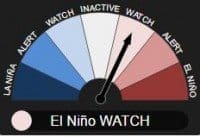The Bureau of Meteorology has announced that the 2022–2023 La Niña has ended. The tropical Pacific Ocean is now in a neutral phase – neither La Niña nor El Niño.
 While the Pacific Ocean is ENSO-neutral, the Bureau has moved to El Niño WATCH as there are there are some signs of El Niño forming later in the year. El Niño WATCH means there is a 50% chance of El Niño in 2023.
While the Pacific Ocean is ENSO-neutral, the Bureau has moved to El Niño WATCH as there are there are some signs of El Niño forming later in the year. El Niño WATCH means there is a 50% chance of El Niño in 2023.
Bureau of Meteorology Technical Lead Extended Prediction Dr Andrew Watkins said after 3 years of La Niña and record-breaking rainfall in eastern Australia, the Bureau’s long-range forecast shows drier than average conditions for most of Australia over the coming months.
“Long-range forecasts show there’s an increased chance of below average rainfall for most of Australia during autumn 2023,” Dr Watkins said.
“But the northern wet season, including the tropical cyclone season, for northern Australia continues during March and April, so there remains the chance of tropical weather systems bringing heavy rain at times to the north.”
If these tropical weather systems extend south, there remains the possibility of periods of heavy rainfall, and flooding, particularly in parts of eastern Australia where soils remain wet and rivers and dams are still full.
Dr Watkins said should the chance of El Niño forming later in 2023 increase to around 70%, the Bureau will change to El Niño ALERT status.
“Even if El Niño impacts Australia, this does not necessarily lead to drought,” he said.
“There have been 27 El Niño years since 1900, and around 18 of those years were affected by widespread winter–spring drought.”
La Niña is the cool phase of the El Niño–Southern Oscillation (ENSO), usually bringing more rain to Australia, while El Niño is the warm phase, where our climate is often drier than usual.
ENSO describes a naturally occurring cycle in the climate system, including the location of warmer or cooler than average sea surface temperatures in the central and eastern tropical Pacific Ocean, and its connection with the trade winds and patterns in the atmosphere. The effects impact weather around large parts of the globe, including Australia.
More information is available on the Bureau’s website:
- Climate long-range forecast: www.bom.gov.au/climate/ahead/
- ENSO forecast: www.bom.gov.au/climate/enso/
outlook - Climate Driver Update: www.bom.gov.au/climate/enso/
- More about El Niño and La Niña: www.bom.gov.au/climate/about/
australian-climate-influences. shtml?bookmark=enso
